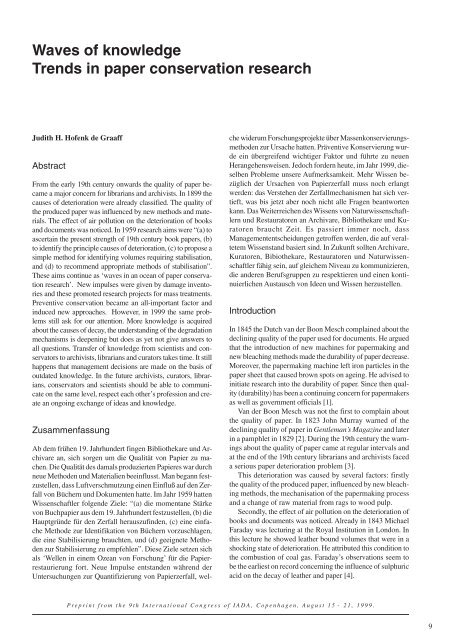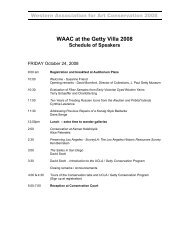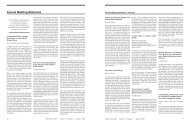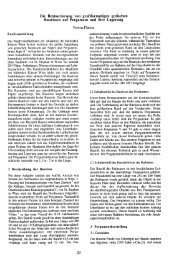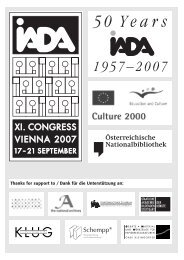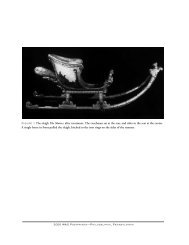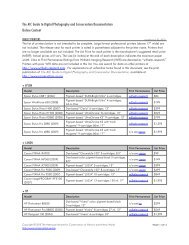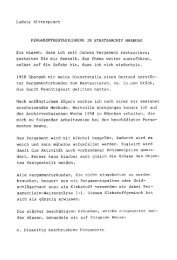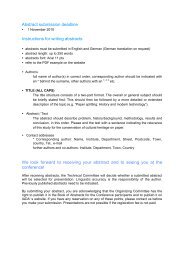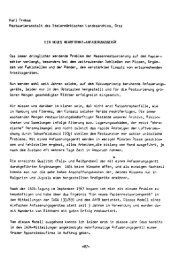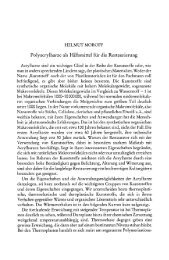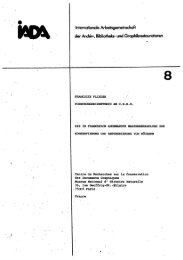Waves of knowledge Trends in paper conservation research - Cool
Waves of knowledge Trends in paper conservation research - Cool
Waves of knowledge Trends in paper conservation research - Cool
Create successful ePaper yourself
Turn your PDF publications into a flip-book with our unique Google optimized e-Paper software.
<strong>Waves</strong> <strong>of</strong> <strong>knowledge</strong><br />
<strong>Trends</strong> <strong>in</strong> <strong>paper</strong> <strong>conservation</strong> <strong>research</strong><br />
Judith H. H<strong>of</strong>enk de Graaff<br />
Abstract<br />
From the early 19th century onwards the quality <strong>of</strong> <strong>paper</strong> became<br />
a major concern for librarians and archivists. In 1899 the<br />
causes <strong>of</strong> deterioration were already classified. The quality <strong>of</strong><br />
the produced <strong>paper</strong> was <strong>in</strong>fluenced by new methods and materials.<br />
The effect <strong>of</strong> air pollution on the deterioration <strong>of</strong> books<br />
and documents was noticed. In 1959 <strong>research</strong> aims were “(a) to<br />
ascerta<strong>in</strong> the present strength <strong>of</strong> 19th century book <strong>paper</strong>s, (b)<br />
to identify the pr<strong>in</strong>ciple causes <strong>of</strong> deterioration, (c) to propose a<br />
simple method for identify<strong>in</strong>g volumes requir<strong>in</strong>g stabilisation,<br />
and (d) to recommend appropriate methods <strong>of</strong> stabilisation”.<br />
These aims cont<strong>in</strong>ue as ‘waves <strong>in</strong> an ocean <strong>of</strong> <strong>paper</strong> <strong>conservation</strong><br />
<strong>research</strong>’. New impulses were given by damage <strong>in</strong>ventories<br />
and these promoted <strong>research</strong> projects for mass treatments.<br />
Preventive <strong>conservation</strong> became an all-important factor and<br />
<strong>in</strong>duced new approaches. However, <strong>in</strong> 1999 the same problems<br />
still ask for our attention. More <strong>knowledge</strong> is acquired<br />
about the causes <strong>of</strong> decay, the understand<strong>in</strong>g <strong>of</strong> the degradation<br />
mechanisms is deepen<strong>in</strong>g but does as yet not give answers to<br />
all questions. Transfer <strong>of</strong> <strong>knowledge</strong> from scientists and conservators<br />
to archivists, librarians and curators takes time. It still<br />
happens that management decisions are made on the basis <strong>of</strong><br />
outdated <strong>knowledge</strong>. In the future archivists, curators, librarians,<br />
conservators and scientists should be able to communicate<br />
on the same level, respect each other’s pr<strong>of</strong>ession and create<br />
an ongo<strong>in</strong>g exchange <strong>of</strong> ideas and <strong>knowledge</strong>.<br />
Zusammenfassung<br />
Ab dem frühen 19. Jahrhundert f<strong>in</strong>gen Bibliothekare und Archivare<br />
an, sich sorgen um die Qualität von Papier zu machen.<br />
Die Qualität des damals produzierten Papieres war durch<br />
neue Methoden und Materialien bee<strong>in</strong>flusst. Man begann festzustellen,<br />
dass Luftverschmutzung e<strong>in</strong>en E<strong>in</strong>fluß auf den Zerfall<br />
von Büchern und Dokumenten hatte. Im Jahr 1959 hatten<br />
Wissenschaftler folgende Ziele: “(a) die momentane Stärke<br />
von Buchpapier aus dem 19. Jahrhundert festzustellen, (b) die<br />
Hauptgründe für den Zerfall herauszuf<strong>in</strong>den, (c) e<strong>in</strong>e e<strong>in</strong>fache<br />
Methode zur Identifikation von Büchern vorzuschlagen,<br />
die e<strong>in</strong>e Stabilisierung brauchten, und (d) geeignete Methoden<br />
zur Stabilisierung zu empfehlen”. Diese Ziele setzen sich<br />
als ‘Wellen <strong>in</strong> e<strong>in</strong>em Ozean von Forschung’ für die Papierrestaurierung<br />
fort. Neue Impulse entstanden während der<br />
Untersuchungen zur Quantifizierung von Papierzerfall, wel-<br />
che widerum Forschungsprojekte über Massenkonservierungsmethoden<br />
zur Ursache hatten. Präventive Konservierung wurde<br />
e<strong>in</strong> übergreifend wichtiger Faktor und führte zu neuen<br />
Herangehensweisen. Jedoch fordern heute, im Jahr 1999, dieselben<br />
Probleme unsere Aufmerksamkeit. Mehr Wissen bezüglich<br />
der Ursachen von Papierzerfall muss noch erlangt<br />
werden: das Verstehen der Zerfallmechanismen hat sich vertieft,<br />
was bis jetzt aber noch nicht alle Fragen beantworten<br />
kann. Das Weiterreichen des Wissens von Naturwissenschaftlern<br />
und Restauratoren an Archivare, Bibliothekare und Kuratoren<br />
braucht Zeit. Es passiert immer noch, dass<br />
Managemententscheidungen getr<strong>of</strong>fen werden, die auf veraltetem<br />
Wissenstand basiert s<strong>in</strong>d. In Zukunft sollten Archivare,<br />
Kuratoren, Bibiothekare, Restauratoren und Naturwissenschaftler<br />
fähig se<strong>in</strong>, auf gleichem Niveau zu kommunizieren,<br />
die anderen Berufsgruppen zu respektieren und e<strong>in</strong>en kont<strong>in</strong>uierlichen<br />
Austausch von Ideen und Wissen herzustellen.<br />
Introduction<br />
In 1845 the Dutch van der Boon Mesch compla<strong>in</strong>ed about the<br />
decl<strong>in</strong><strong>in</strong>g quality <strong>of</strong> the <strong>paper</strong> used for documents. He argued<br />
that the <strong>in</strong>troduction <strong>of</strong> new mach<strong>in</strong>es for <strong>paper</strong>mak<strong>in</strong>g and<br />
new bleach<strong>in</strong>g methods made the durability <strong>of</strong> <strong>paper</strong> decrease.<br />
Moreover, the <strong>paper</strong>mak<strong>in</strong>g mach<strong>in</strong>e left iron particles <strong>in</strong> the<br />
<strong>paper</strong> sheet that caused brown spots on age<strong>in</strong>g. He advised to<br />
<strong>in</strong>itiate <strong>research</strong> <strong>in</strong>to the durability <strong>of</strong> <strong>paper</strong>. S<strong>in</strong>ce then quality<br />
(durability) has been a cont<strong>in</strong>u<strong>in</strong>g concern for <strong>paper</strong>makers<br />
as well as government <strong>of</strong>ficials [1].<br />
Van der Boon Mesch was not the first to compla<strong>in</strong> about<br />
the quality <strong>of</strong> <strong>paper</strong>. In 1823 John Murray warned <strong>of</strong> the<br />
decl<strong>in</strong><strong>in</strong>g quality <strong>of</strong> <strong>paper</strong> <strong>in</strong> Gentleman’s Magaz<strong>in</strong>e and later<br />
<strong>in</strong> a pamphlet <strong>in</strong> 1829 [2]. Dur<strong>in</strong>g the 19th century the warn<strong>in</strong>gs<br />
about the quality <strong>of</strong> <strong>paper</strong> came at regular <strong>in</strong>tervals and<br />
at the end <strong>of</strong> the 19th century librarians and archivists faced<br />
a serious <strong>paper</strong> deterioration problem [3].<br />
This deterioration was caused by several factors: firstly<br />
the quality <strong>of</strong> the produced <strong>paper</strong>, <strong>in</strong>fluenced by new bleach<strong>in</strong>g<br />
methods, the mechanisation <strong>of</strong> the <strong>paper</strong>mak<strong>in</strong>g process<br />
and a change <strong>of</strong> raw material from rags to wood pulp.<br />
Secondly, the effect <strong>of</strong> air pollution on the deterioration <strong>of</strong><br />
books and documents was noticed. Already <strong>in</strong> 1843 Michael<br />
Faraday was lectur<strong>in</strong>g at the Royal Institution <strong>in</strong> London. In<br />
this lecture he showed leather bound volumes that were <strong>in</strong> a<br />
shock<strong>in</strong>g state <strong>of</strong> deterioration. He attributed this condition to<br />
the combustion <strong>of</strong> coal gas. Faraday’s observations seem to<br />
be the earliest on record concern<strong>in</strong>g the <strong>in</strong>fluence <strong>of</strong> sulphuric<br />
acid on the decay <strong>of</strong> leather and <strong>paper</strong> [4].<br />
Prepr<strong>in</strong>t from the 9th International Congress <strong>of</strong> IADA, Copenhagen, August 15 - 21, 1999.<br />
9
10<br />
Thirdly the <strong>in</strong>fluence <strong>of</strong> the writ<strong>in</strong>g materials was noticed.<br />
The problem <strong>of</strong> iron gall <strong>in</strong>k corrosion was already a topic at<br />
an <strong>in</strong>ternational conference <strong>in</strong> St. Gallen <strong>in</strong> 1899 [5].<br />
In 1897 an <strong>in</strong>vestigation was conducted by the Committee<br />
on the Deterioration <strong>of</strong> Paper appo<strong>in</strong>ted by the Society <strong>of</strong> the<br />
Arts (London), but <strong>in</strong> an <strong>in</strong>fluential report published <strong>in</strong> May<br />
1898 the Committee reported that “the danger had been overestimated”<br />
[6]. This remark sounds quite familiar to modern<br />
ears. Even nowadays important <strong>research</strong> programs are conducted;<br />
the results are greeted with concern, but forgotten quite<br />
soon.<br />
From these historical sources it may become clear that already<br />
<strong>in</strong> the 19th century the <strong>knowledge</strong> <strong>of</strong> the <strong>in</strong>fluence <strong>of</strong><br />
two different factors - an <strong>in</strong>ternal one and an external one - on<br />
the deterioration <strong>of</strong> <strong>paper</strong> objects was recognised. The <strong>in</strong>ternal<br />
factor was <strong>in</strong>troduced by the <strong>paper</strong> production - preparation<br />
<strong>of</strong> the raw material and the sheet formation - and the external<br />
factor was the <strong>in</strong>fluence <strong>of</strong> air pollution. Also the<br />
degrad<strong>in</strong>g effects <strong>of</strong> writ<strong>in</strong>g material can be classified as an<br />
external factor. It is <strong>in</strong>terest<strong>in</strong>g that <strong>in</strong> this review the <strong>in</strong>fluence<br />
<strong>of</strong> the alum/ros<strong>in</strong> siz<strong>in</strong>g is not yet mentioned. The topics<br />
<strong>paper</strong>mak<strong>in</strong>g and permanence, air pollution, humidity and temperature<br />
control and writ<strong>in</strong>g and pr<strong>in</strong>t<strong>in</strong>g materials already<br />
characterised today’s <strong>paper</strong> <strong>conservation</strong> <strong>research</strong>. The emphasis<br />
has changed, our <strong>knowledge</strong> is cont<strong>in</strong>ually expanded,<br />
but the topics are still the same.<br />
Paper Permanence/Durability<br />
Research <strong>in</strong>to <strong>paper</strong> <strong>conservation</strong> has always had a strong<br />
connection to <strong>research</strong> <strong>in</strong> the <strong>paper</strong> <strong>in</strong>dustry. Before the development<br />
<strong>of</strong> <strong>paper</strong> <strong>conservation</strong> as a real pr<strong>of</strong>ession <strong>research</strong><br />
was ma<strong>in</strong>ly carried out for the benefit <strong>of</strong> the <strong>paper</strong> <strong>in</strong>dustry.<br />
It was directed at raw materials and production processes.<br />
S<strong>in</strong>ce the end <strong>of</strong> the 19th century until the beg<strong>in</strong>n<strong>in</strong>g <strong>of</strong> the<br />
1950’s the basic process <strong>of</strong> <strong>paper</strong>mak<strong>in</strong>g stayed the same,<br />
although new and faster production methods were <strong>in</strong>troduced.<br />
Various qualities were available and standards for <strong>paper</strong>s for<br />
various purposes were developed. In the Netherlands a standard<br />
existed for <strong>paper</strong> to be used <strong>in</strong> the government and it was<br />
stated that rag <strong>paper</strong> had to be used for government documents<br />
[7]. These regulations were not only <strong>in</strong>troduced <strong>in</strong> the<br />
Netherlands but <strong>in</strong> all European countries and <strong>in</strong> the United<br />
States. The concern for more permanent <strong>paper</strong> came not only<br />
from government <strong>of</strong>ficials but also more and more from librarians<br />
and archivists. Librarians were confronted with ever<br />
larger quantities <strong>of</strong> crumbl<strong>in</strong>g books.<br />
The first impulse to <strong>conservation</strong> <strong>research</strong> was focussed<br />
more on the improvement <strong>of</strong> the durability <strong>of</strong> new <strong>paper</strong> than<br />
on the active <strong>conservation</strong> <strong>of</strong> already degraded <strong>paper</strong> <strong>in</strong> libraries<br />
and archives. William J. Barrow was one <strong>of</strong> the first<br />
scientists who conducted an <strong>in</strong>vestigation under auspices <strong>of</strong><br />
the Virg<strong>in</strong>ia State Library to ascerta<strong>in</strong> the cause and to explore<br />
the possible remedies for the deterioration <strong>of</strong> book stock<br />
<strong>in</strong> American Libraries <strong>in</strong> 1957-58 [8]. In his study 500 books<br />
from the period 1900-1945, that is 100 for each decade were<br />
<strong>in</strong>vestigated. In 1963 –1965 <strong>paper</strong>s dat<strong>in</strong>g from the period<br />
1800-1899 were <strong>in</strong>vestigated. Barrow mentions the follow-<br />
<strong>in</strong>g aims <strong>of</strong> this <strong>research</strong> “(a) to ascerta<strong>in</strong> the present strength<br />
<strong>of</strong> 19th century book <strong>paper</strong>s, (b) to identify the pr<strong>in</strong>ciple<br />
causes <strong>of</strong> deterioration, (c) to propose a simple method for<br />
identify<strong>in</strong>g volumes requir<strong>in</strong>g stabilisation, and (d) to recommend<br />
appropriate methods <strong>of</strong> stabilisation” [9]. These<br />
aims were <strong>in</strong> fact the same as those <strong>of</strong> the Committee on the<br />
Deterioration <strong>of</strong> Paper <strong>in</strong> 1898.<br />
The results <strong>of</strong> Barrow’s <strong>research</strong> were not so reassur<strong>in</strong>g<br />
as those <strong>in</strong> 1898, but more to the contrary. He brought the<br />
disastrous <strong>in</strong>fluence <strong>of</strong> the acidity, caused by the use <strong>of</strong> alum/<br />
ros<strong>in</strong> siz<strong>in</strong>g, <strong>in</strong>to light, and the decrease <strong>of</strong> quality by the use<br />
<strong>of</strong> wood pulp as a raw material. Compared to the state <strong>of</strong><br />
<strong>knowledge</strong> <strong>in</strong> 1898 the <strong>in</strong>fluence <strong>of</strong> the alum/ros<strong>in</strong> siz<strong>in</strong>g<br />
was a new factor. The <strong>in</strong>troduction <strong>of</strong> the pH as an all-important<br />
parameter for decisions on treatment was now established.<br />
Barrow concluded that 19th century book <strong>paper</strong>s with<br />
a pH-value lower than 6.0 needed stabilisation.<br />
Barrow was not unfamiliar with <strong>paper</strong> <strong>research</strong>. His laboratory<br />
started <strong>in</strong> 1936 but rema<strong>in</strong>ed relatively small until the<br />
Council <strong>of</strong> Library Resources and the Ford Foundation made<br />
it possible to acquire facilities with the best <strong>paper</strong>-test<strong>in</strong>g equipment.<br />
On the basis <strong>of</strong> the first <strong>in</strong>vestigations a larger program<br />
started <strong>in</strong>to the “Permanence/Durability <strong>of</strong> the Book” and this<br />
program <strong>in</strong>itiated the <strong>research</strong> <strong>in</strong>to active <strong>conservation</strong> methods.<br />
The deacidification <strong>of</strong> <strong>paper</strong> as a <strong>conservation</strong> method<br />
was born. The method first developed was deacidification with<br />
aqueous solutions <strong>of</strong> calcium hydroxide and calcium bicarbonate.<br />
The work <strong>of</strong> Barrow and his laboratory cont<strong>in</strong>ued until<br />
the beg<strong>in</strong>n<strong>in</strong>g <strong>of</strong> the eighties and a series <strong>of</strong> publications on<br />
the “Permanence/Durability <strong>of</strong> the Book” came to light [10].<br />
Several other <strong>in</strong>itiatives were taken to develop deacidification<br />
methods, aqueous as well as non-aqueous ones, but none<br />
<strong>of</strong> them gave the ultimate solution [11].<br />
Mass deacidification<br />
A new wave <strong>of</strong> <strong>research</strong> <strong>in</strong>to the extent <strong>of</strong> the problem was<br />
started <strong>in</strong> 1979 with a damage <strong>in</strong>ventory by the Stanford<br />
University, followed by several others <strong>in</strong>clud<strong>in</strong>g the damage<br />
<strong>in</strong>ventory <strong>in</strong> 1990 <strong>in</strong> the Netherlands [12]. The conclusions<br />
<strong>of</strong> these programs <strong>in</strong>to the state <strong>of</strong> damage were the same:<br />
about 40% <strong>of</strong> the 19th century <strong>paper</strong>, <strong>in</strong> particular from the<br />
period 1870-1890 was seriously damaged. The use <strong>of</strong> bad<br />
quality wood pulp and the alum/ros<strong>in</strong> siz<strong>in</strong>g were the causes<br />
for this condition. From the various damage <strong>in</strong>ventories the<br />
extent <strong>of</strong> the problem became more and more clear and the<br />
only solution for deacidification on a large scale seemed to<br />
be a ‘mass treatment’ approach.<br />
Research <strong>in</strong>to mass <strong>conservation</strong> treatment started with<br />
magnesium methoxide, a solvent based deacidification<br />
method. In Canada, the US and France various facilities were<br />
set up and the effect <strong>of</strong> the method was <strong>in</strong>vestigated. At the<br />
same time the gaseous treatment with Di Ethyl Z<strong>in</strong>c (DEZ)<br />
was developed by the Library <strong>of</strong> Congress [13]. The methods<br />
<strong>of</strong> <strong>in</strong>vestigation were the standard methods from the <strong>paper</strong><br />
<strong>in</strong>dustry: mechanical properties were measured, as well as<br />
the pH and the degree <strong>of</strong> polymerisation. To predict the effect<br />
<strong>of</strong> the treatment on the long term, accelerated age<strong>in</strong>g
methods were used. The first standard method for accelerated<br />
age<strong>in</strong>g was a dry oven method (105ºC). At the same<br />
time the discussion on the relation between natural age<strong>in</strong>g<br />
and artificial age<strong>in</strong>g started. In 1980 an important study on<br />
this relation was published by Wilson and Parks [14]. New<br />
standards were developed and the ISO standard gave three<br />
different options for accelerated age<strong>in</strong>g: 105ºC and 80ºC at<br />
65% RH; 90ºC and 50% RH [15].<br />
An extensive <strong>research</strong> program <strong>in</strong> the US compared the<br />
various mass treatments to make a def<strong>in</strong>ite choice. However,<br />
this <strong>research</strong> showed that none <strong>of</strong> the methods was<br />
without negative effects and the decision to start a mass treatment<br />
was postponed [16]. The <strong>research</strong> <strong>in</strong>to new mass treatments<br />
went on and on and methods as promoted by Batelle<br />
and Bookkeeper are nowadays further developed. A mass<br />
treatment is still an utopia. The treatment <strong>of</strong> large amounts<br />
has started at several places but it is clear that <strong>in</strong> future different<br />
methods for different purposes will exist and choices<br />
and selections will have to be made.<br />
Strengthen<strong>in</strong>g <strong>of</strong> brittle <strong>paper</strong><br />
The impulse for the <strong>research</strong> programs <strong>in</strong>to the cause <strong>of</strong> degradation<br />
mentioned before was given by the physical state <strong>of</strong> 19th<br />
century <strong>paper</strong>. The crumbl<strong>in</strong>g <strong>of</strong> <strong>paper</strong> leaves asked for re<strong>in</strong>forcement.<br />
Traditional methods accord<strong>in</strong>g to which tears were<br />
pasted with starch paste and supported with European <strong>paper</strong><br />
were followed by the <strong>in</strong>troduction <strong>of</strong> rel<strong>in</strong><strong>in</strong>g whole pages with<br />
Japanese <strong>paper</strong> and starch. Also th<strong>in</strong> silk fabrics <strong>in</strong> comb<strong>in</strong>ation<br />
with gelat<strong>in</strong>e were used to re<strong>in</strong>force the strength <strong>of</strong> <strong>in</strong>dividual<br />
<strong>paper</strong> leaves. The development <strong>of</strong> synthetic materials led to the<br />
development <strong>of</strong> new <strong>conservation</strong> methods. However, <strong>knowledge</strong><br />
about the durability <strong>of</strong> synthetic materials and their possible<br />
effects on the stability were non-existent.<br />
As the amounts <strong>of</strong> materials to be treated were large, the<br />
leaf cast<strong>in</strong>g method was developed <strong>in</strong>to a mechanised system.<br />
Today we are still confronted with the disastrous outcome<br />
<strong>of</strong> this wave <strong>of</strong> the all too speedy <strong>in</strong>troduction <strong>of</strong> developments,<br />
which weren’t <strong>in</strong>vestigated properly <strong>in</strong> advance.<br />
As the <strong>conservation</strong> pr<strong>of</strong>ession developed rapidly from the<br />
seventies, this method was criticised by the <strong>conservation</strong><br />
community but unfortunately still applied <strong>in</strong> <strong>in</strong>stitutions<br />
where well-tra<strong>in</strong>ed conservators were absent. However, when<br />
the <strong>research</strong> <strong>in</strong>to mass deacidification started, the need for<br />
re<strong>in</strong>forcement <strong>of</strong> brittle <strong>paper</strong> rema<strong>in</strong>ed. As the deacidification<br />
process did not re<strong>in</strong>force the strength <strong>of</strong> the <strong>paper</strong> which<br />
was already degraded <strong>in</strong>to ‘brittle <strong>paper</strong>’, methods were developed<br />
to strengthen and deacidify <strong>in</strong> one process. The graft<br />
polymerisation process <strong>of</strong> the British Library is a good example,<br />
but it never came out <strong>of</strong> the laboratory stage.<br />
Also <strong>in</strong> the German <strong>paper</strong> splitt<strong>in</strong>g method re<strong>in</strong>forcement<br />
and deacidification are brought about <strong>in</strong> one process. Started<br />
as a s<strong>in</strong>gle item-method it developed <strong>in</strong>to an automated process.<br />
The <strong>paper</strong> splitt<strong>in</strong>g method is used for large amounts <strong>of</strong><br />
material. A mass <strong>conservation</strong> treatment method, which is<br />
generally applicable, has not been found yet.<br />
Another problem related to acidic degradation <strong>of</strong> <strong>paper</strong> is<br />
that <strong>of</strong> writ<strong>in</strong>g and pr<strong>in</strong>t<strong>in</strong>g applied to <strong>paper</strong>. Particularly the<br />
<strong>in</strong>fluence <strong>of</strong> iron gall <strong>in</strong>k on the stability <strong>of</strong> <strong>paper</strong> has been a<br />
major concern. As mentioned before, already <strong>in</strong> 1899 the<br />
first conference on the problems caused by iron gall <strong>in</strong>k was<br />
held. A second wave <strong>of</strong> <strong>research</strong> started <strong>in</strong> the 1980’s <strong>in</strong> Austria<br />
where iron gall <strong>in</strong>k decay as well the effects <strong>of</strong> copper<br />
green were studied. However, an uncerta<strong>in</strong>ty rema<strong>in</strong>ed about<br />
the cause and remedy <strong>of</strong> iron gall <strong>in</strong>k corrosion [17]. In the<br />
n<strong>in</strong>eties a new <strong>research</strong> program started <strong>in</strong> the Netherlands<br />
which gave more <strong>in</strong>sight <strong>in</strong>to the degradation mechanism<br />
and which provided a method for stopp<strong>in</strong>g iron gall <strong>in</strong>k corrosion<br />
[18].<br />
Preventive <strong>conservation</strong><br />
Dur<strong>in</strong>g <strong>research</strong> <strong>in</strong>to mass deacidification and dur<strong>in</strong>g the<br />
phase when damage <strong>in</strong>ventories were made, the criteria for<br />
mak<strong>in</strong>g decisions came <strong>in</strong>to discussion. From the <strong>research</strong> it<br />
became clear that the pH-value could not be used any more<br />
as the s<strong>in</strong>gle criterion. Paper from the 18th century (and earlier)<br />
<strong>of</strong>ten had a pH below 5.0 and was still <strong>in</strong> good condition.<br />
Thus also the time <strong>of</strong> production, the presence <strong>of</strong> lign<strong>in</strong><br />
and a hand-fold<strong>in</strong>g number became criteria on which decisions<br />
for a possible deacidification treatment were made. The<br />
discussion which followed the damage <strong>in</strong>ventories and the<br />
subsequent need for mass deacidification processes also resulted<br />
<strong>in</strong> the awareness <strong>of</strong> the need for more extensive preventive<br />
<strong>conservation</strong> methods.<br />
The change from active <strong>conservation</strong> to preventive <strong>conservation</strong><br />
became an important trend <strong>in</strong> the whole field <strong>of</strong><br />
<strong>conservation</strong>. This tendency had various causes. On the one<br />
hand the <strong>in</strong>terest <strong>in</strong> the <strong>in</strong>tr<strong>in</strong>sic value <strong>of</strong> the object and <strong>in</strong><br />
the object as a carrier <strong>of</strong> <strong>in</strong>formation became an important<br />
topic <strong>in</strong> the discussion on the ethics <strong>of</strong> <strong>conservation</strong>. On the<br />
other hand conservators were <strong>of</strong>ten confronted with the disasters<br />
caused by less tra<strong>in</strong>ed predecessors. To keep your<br />
‘hands <strong>of</strong>f’ became the new trend <strong>in</strong> <strong>conservation</strong> practice.<br />
The <strong>research</strong> <strong>in</strong>to possibilities and effects <strong>of</strong> preventive <strong>conservation</strong><br />
went different ways. In the Netherlands, from 1990<br />
onwards, the so-called “Deltaplan voor het Cultuurbehoud”<br />
was launched [19]. In this project the Dutch government gave<br />
extra money for proper registration, storage facilities and<br />
<strong>conservation</strong> projects. Research was focussed on the <strong>in</strong>fluence<br />
<strong>of</strong> the environment (air quality, temperature and humidity)<br />
on the deterioration <strong>of</strong> objects, the use <strong>of</strong> good quality<br />
storage materials and the <strong>in</strong>fluence <strong>of</strong> wrapp<strong>in</strong>g and<br />
pack<strong>in</strong>g on the lifespan <strong>of</strong> objects. However, not only <strong>in</strong> the<br />
Netherlands the focus on preventive <strong>conservation</strong> became<br />
important. In various countries standards for hous<strong>in</strong>g, humidity<br />
control and storage materials were developed [20].<br />
In preventive <strong>conservation</strong> the fight aga<strong>in</strong>st mould attack<br />
plays an important role <strong>in</strong> archives and libraries. As <strong>in</strong> many<br />
other <strong>conservation</strong> treatments the large amounts <strong>of</strong> material<br />
to be treated <strong>in</strong> case <strong>of</strong> a calamity <strong>in</strong>fluences the type <strong>of</strong> the<br />
treatment. Many <strong>research</strong> projects have been carried out on<br />
the <strong>in</strong>fluence <strong>of</strong> pesticides. Particularly the <strong>in</strong>fluence <strong>of</strong> ethylene<br />
oxide and the use <strong>of</strong> gamma irradiation were <strong>in</strong>vestigated.<br />
As the use <strong>of</strong> ethylene oxide is forbidden <strong>in</strong> most European<br />
countries and the US and the negative <strong>in</strong>fluence <strong>of</strong> a<br />
11
12<br />
treatment with gamma irradiation on age<strong>in</strong>g became known.<br />
The emphasis on preventive <strong>conservation</strong> and ‘good house<br />
keep<strong>in</strong>g’ became even more important.<br />
A large <strong>research</strong> program was started <strong>in</strong> the Netherlands,<br />
stimulated by the government, which <strong>in</strong>vestigated the <strong>in</strong>fluence<br />
<strong>of</strong> sulphur dioxide <strong>in</strong> comb<strong>in</strong>ation with nitrogen oxide<br />
(ACBAM) as air pollutants. A new program <strong>in</strong> which <strong>research</strong><br />
<strong>in</strong>stitutes <strong>in</strong> France, Sweden and the Netherlands co-operated<br />
cont<strong>in</strong>ued this program. The <strong>in</strong>fluence <strong>of</strong> air pollution as well<br />
as the effects <strong>of</strong> various mass deacidification methods was <strong>in</strong>vestigated.<br />
The <strong>research</strong> program was funded by the European<br />
Commission [21]. The results <strong>of</strong> the <strong>in</strong>vestigations were comparable<br />
to those <strong>of</strong> 1898. However, the <strong>knowledge</strong> about why<br />
and to which extent a comb<strong>in</strong>ation <strong>of</strong> SO 2 and NO x has a serious<br />
effect on the permanence <strong>of</strong> <strong>paper</strong> <strong>in</strong>creased substantially.<br />
These effects <strong>of</strong> environmental conditions were also shown <strong>in</strong> a<br />
<strong>research</strong> project <strong>in</strong> which book pairs <strong>in</strong> the New York Public<br />
Library and at The Royal Library <strong>in</strong> The Hague were compared.<br />
In this <strong>research</strong> air pollution as well as temperature and<br />
humidity changes showed their disastrous results [22].<br />
New trends<br />
The emphasis on preventive <strong>conservation</strong> has given new directions<br />
to <strong>research</strong>. The discovery <strong>of</strong> the yellow<strong>in</strong>g <strong>of</strong> <strong>paper</strong><br />
<strong>in</strong>side the cutout <strong>of</strong> a passe-partout (mat) raised questions about<br />
the effects <strong>of</strong> a microclimate <strong>in</strong>side boxes and frames [23].<br />
The effects <strong>of</strong> changes <strong>of</strong> relative humidity and temperature<br />
on the oxidation <strong>of</strong> <strong>paper</strong> and its consequent yellow<strong>in</strong>g are a<br />
topic for ongo<strong>in</strong>g <strong>research</strong>. The <strong>research</strong> is focussed on the<br />
effects <strong>of</strong> both parameters <strong>in</strong> micro-systems as well as <strong>in</strong><br />
climatised storage rooms. Is the strict climatisation as it is<br />
now advertised really necessary? To which extent is it necessary<br />
to keep the relative humidity absolutely equable <strong>in</strong> a situation<br />
where objects are stored <strong>in</strong> boxes? Or is it more important<br />
to keep the temperature constant?<br />
Problems around the deacidification processes have raised<br />
questions on the effectiveness <strong>of</strong> the method. Questions about<br />
the necessary amount <strong>of</strong> alkal<strong>in</strong>e reserve are raised and from<br />
a quick literature search it seems that the 2% alkal<strong>in</strong>e reserve<br />
<strong>in</strong>ternationally used as a criterion is not based on specific<br />
<strong>research</strong>. Another question is to what extent large<br />
amounts <strong>of</strong> alkal<strong>in</strong>e reserve can cause alkali-<strong>in</strong>duced hydrolysis<br />
<strong>of</strong> <strong>paper</strong>. A literature <strong>research</strong> was recently f<strong>in</strong>ished but<br />
obviously more <strong>research</strong> is needed [24].<br />
In view <strong>of</strong> mass deacidification librarians and archivists pose<br />
questions about the life expectancy <strong>of</strong> treated and non-treated<br />
books and documents. As ‘mass treatments’ ask for high <strong>in</strong>vestments,<br />
librarians and archivists want to know how long they<br />
can postpone the treatment. This question has started a new<br />
discussion on the effectiveness <strong>of</strong> methods for accelerated age<strong>in</strong>g<br />
. To what extent is it possible to predict the permanence <strong>of</strong><br />
<strong>paper</strong> <strong>in</strong> years and the effects <strong>of</strong> a treatment <strong>in</strong> the long term? A<br />
critical literature study, <strong>in</strong> which the various accelerated age<strong>in</strong>g<br />
methods are scrut<strong>in</strong>ised, is nearly f<strong>in</strong>ished [25].<br />
As the exist<strong>in</strong>g mass treatment-methods are <strong>in</strong> reality not<br />
suitable for treatment on a very large scale, a method for<br />
selection <strong>of</strong> endangered objects is needed. Dur<strong>in</strong>g the dam-<br />
age <strong>in</strong>ventories various test<strong>in</strong>g methods for selection were<br />
developed. However, these methods ask for relative large<br />
amounts <strong>of</strong> material and have their limitations <strong>in</strong> case <strong>of</strong> orig<strong>in</strong>al<br />
objects. Therefore, a <strong>research</strong> project is started <strong>in</strong>to microanalytical<br />
methods for the quantification <strong>of</strong> the condition <strong>of</strong><br />
<strong>paper</strong> [26]. Another project <strong>in</strong> this respect is the <strong>in</strong>vestigation<br />
<strong>of</strong> the ‘sacred cow’ <strong>in</strong> <strong>paper</strong> <strong>conservation</strong>, the pH <strong>of</strong> <strong>paper</strong><br />
[27]. What does the pH mean, does it give <strong>in</strong>formation on the<br />
condition <strong>of</strong> <strong>paper</strong>? How can it be used <strong>in</strong> a selection process?<br />
The surf effect<br />
After several years <strong>of</strong> emphasis on preventive <strong>conservation</strong> a feel<strong>in</strong>g<br />
<strong>of</strong> comfort has been created <strong>in</strong> the m<strong>in</strong>ds <strong>of</strong> archivists, librarians<br />
and curators. It is a fact that many objects, books and documents<br />
are stored <strong>in</strong> climate-controlled storage areas, adequate<br />
preservation methods have been developed, and science can give<br />
answers to many questions. However, problems still exist. More<br />
<strong>knowledge</strong> is acquired about the causes <strong>of</strong> decay, the understand<strong>in</strong>g<br />
<strong>of</strong> the degradation mechanisms is deepen<strong>in</strong>g but does as yet<br />
not give answers to all questions. Each <strong>research</strong> project enlarges<br />
our <strong>knowledge</strong> and does <strong>of</strong>ten change our attitude to the problem<br />
under <strong>in</strong>vestigation. From the past I have learned that the transfer<br />
<strong>of</strong> <strong>knowledge</strong> from scientists and conservators to archivists, librarians<br />
and curators takes time. It still happens that management<br />
decisions are taken on the basis <strong>of</strong> outdated <strong>knowledge</strong>.<br />
The new <strong>knowledge</strong> obta<strong>in</strong>ed by conservators and scientists but<br />
not yet known to the decision-makers is washed over by what I<br />
would call the surf <strong>of</strong> decisions. This situation <strong>of</strong>ten causes tensions<br />
between decision-makers and conservators. For the <strong>conservation</strong><br />
field one <strong>of</strong> the most important trends for the future<br />
should be the creation <strong>of</strong> a situation where archivists, curators,<br />
librarians, conservators and scientists are able to communicate<br />
on the same level, respect each other’s pr<strong>of</strong>ession and create an<br />
ongo<strong>in</strong>g exchange <strong>of</strong> ideas and <strong>knowledge</strong>. In this way the preservation<br />
<strong>of</strong> our cultural heritage would be <strong>in</strong> good hands.<br />
Notes<br />
1. Van der Grijn, E., Kard<strong>in</strong>aal, A., Porck, H., ‘The 1845<br />
<strong>paper</strong> crisis <strong>in</strong> the Netherlands- An historical-technical<br />
study <strong>in</strong>to the Dutch <strong>paper</strong> market and the extent <strong>of</strong> the<br />
<strong>in</strong>ferior quality <strong>of</strong> mid-19th century <strong>paper</strong>’, IPH Yearbook<br />
1996, <strong>in</strong> press<br />
2. Murray, J., Practical Remarks on Modern Paper, Ed<strong>in</strong>burgh,<br />
1829<br />
3. Barrow, W.J., The Permanence/Durability <strong>of</strong> the Book -<br />
V. Richmond ,1967<br />
4. Faraday, M., On the Ventilation <strong>of</strong> Lamp Burners, Royal<br />
Institution Lecture, 7 April 1843<br />
5. Nicholson, E.W.B., Report by the Bodleian Librarian to<br />
the Curators <strong>of</strong> the Bodleian Library, on the Conference<br />
held at St. Gallen, Sept. 30 and Oct. 1, 1899, upon the<br />
Preservation and Repair <strong>of</strong> old MMS., Oxford, 1899<br />
6. ‘Report <strong>of</strong> the Committee on the Deterioration <strong>of</strong> Paper’,<br />
Journal <strong>of</strong> the Society <strong>of</strong> Arts, (London) 46:597-601, 698-9,<br />
May 20, July 1, 1989
7. Het Papierbesluit 1928<br />
8. Virg<strong>in</strong>ia State Library, Deterioration <strong>of</strong> Book Stock - Causes<br />
and Remedies; Two Studies on the Permanence <strong>of</strong> Book<br />
Paper, conducted by William J. Barrow. Edited by<br />
Randolph W. Church, Richmond, 1959<br />
9. Barrow, W.J., The Permanence/Durability <strong>of</strong> the Book - V.<br />
Richmond, 1967 p. 35<br />
10. Barrow, W.J., The Permanence /Durability <strong>of</strong> the Book,<br />
I-VII, Richmond, 1959-1969<br />
11. Smith, R., The Non-aqueous Deacidification <strong>of</strong> Paper and<br />
Books, Ph.D. Dissertation, University <strong>of</strong> Chicago, 1970<br />
12. Bender, Y., Papierconserver<strong>in</strong>g <strong>in</strong> Nederland. Een<br />
overzicht van de ontwikkel<strong>in</strong>gen <strong>in</strong> de periode 1980-1995.<br />
CNC-publicatie Den Haag, 1996<br />
13. Porck, H., Mass Deacidification: an Update <strong>of</strong> Possibilities<br />
and Limitations, European Commission on Preservation<br />
and Access, Amsterdam, 1996<br />
14. Wilson, W.K., Parks, E.J., ‘Comparison <strong>of</strong> Accelerated<br />
Age<strong>in</strong>g <strong>of</strong> Book Papers <strong>in</strong> 1937 with 36 Years <strong>of</strong> Natural<br />
Age<strong>in</strong>g’, Restaurator, 4 (1980) 1-55<br />
15. ISO Standard 5630, Paper and board – Accelerated age<strong>in</strong>g,<br />
1986<br />
16. Physical properties (1991 a,b,c), Physical Properties <strong>of</strong><br />
Library Books Deacidified with …. Report to the Library<br />
<strong>of</strong> Congress Contracts & Logistics Services… <strong>in</strong> Response<br />
to Solitation. No. RFP 90-32 Institute <strong>of</strong> Paper Science<br />
and Technology , Atlanta, 1991<br />
17. Banik, G., Stachelberger,H., Phänomene und Ursachen<br />
von Farb- und T<strong>in</strong>tenfraß. Alfred Vendl und Bernhard<br />
Pichler, Hg., Wiener Berichte über Naturwissenschaft <strong>in</strong><br />
der Kunst 1, Wien, Sonderdruck (1984): 188-213.<br />
18. Neevel, J. G., ‘Phytate: A Potential Conservation Agent<br />
for the Treatment <strong>of</strong> Ink Corrosion caused by Iron Gall<br />
Inks’, Restaurator 16 (1995): 143-160.<br />
19. Deltaplan voor het Cultuurbehoud, Onderdeel: Plan van<br />
aanpak achterstanden musea, archieven, monumentenzorg,<br />
archeologie, Rijswijk, 1990<br />
20. BS 5454:1977 Recommendations for The Storage and<br />
Exhibition <strong>of</strong> Archival Documents, British Standard Institution,<br />
1977<br />
21. Havermans, J.B.G.A., et al. The Effects <strong>of</strong> Air Pollution<br />
on the Accelerated Age<strong>in</strong>g <strong>of</strong> Cellulose Conta<strong>in</strong><strong>in</strong>g Material<br />
– Paper EC/DCXII/STEP Project CT 90-0100, TNO,<br />
Delft, The Netherlands<br />
22. Pauk, S., Porck, H., Land om Land. Verslag van de<br />
bestuder<strong>in</strong>g van identieke boekenparen, die onder<br />
verschillende omstandigheden zijn bewaard. Kon<strong>in</strong>klijke<br />
Bibliotheek, Den Haag, 1996<br />
23. H<strong>of</strong>enk de Graaff, J.H., ‘Research <strong>in</strong>to the cause <strong>of</strong><br />
brown<strong>in</strong>g <strong>of</strong> <strong>paper</strong> mounted <strong>in</strong> mats’, Contributions <strong>of</strong><br />
the Central Research Laboratory to the field <strong>of</strong> <strong>conservation</strong><br />
and restoration, Amsterdam 1994 21-42<br />
24. Havermans, J.B.G.A., Ontzuren van Papier: Een redd<strong>in</strong>g<br />
<strong>of</strong> een Tijdbom, TNO report BU2.98/009975-/JH Delft,<br />
1998, <strong>in</strong> opdracht van het ICN Amsterdam<br />
25. Porck, H., Snelheid van Papierverval. De betrouwbaarheid<br />
van prognoses op basis van kunstmatige verouder<strong>in</strong>gstests.<br />
Kon<strong>in</strong>klijke Bibliotheek Den Haag, <strong>in</strong> press<br />
26. Pedersoli Jr, J.L., The Development <strong>of</strong> Microanalytical<br />
Methods for the Characterization <strong>of</strong> Degradation <strong>of</strong> Paperbased<br />
Objects <strong>of</strong> Cultural Value, Research <strong>in</strong> progress,<br />
Netherlands Institute for Cultural Heritage, Amsterdam<br />
27. Wouters, J., Research <strong>in</strong> progress, Kon<strong>in</strong>klijk Instituut<br />
voor het Kunstpatrimonium, Brussel<br />
Biography<br />
Judith H. H<strong>of</strong>enk de Graaff is a textile chemist and holds<br />
a doctorate <strong>in</strong> history from The Free University <strong>of</strong> Amsterdam.<br />
S<strong>in</strong>ce 1984 she was Co-ord<strong>in</strong>ator <strong>of</strong> the scientific department<br />
<strong>of</strong> the Central Research Laboratory for Objects <strong>of</strong><br />
Art and Science <strong>in</strong> Amsterdam (founded <strong>in</strong> 1963). S<strong>in</strong>ce 1999<br />
she is Head <strong>of</strong> the Conservation Research Department <strong>of</strong> the<br />
Netherlands Institute for Cultural Heritage (Instituut Collectie<br />
Nederland, ICN) <strong>in</strong> Amsterdam. The <strong>research</strong> activities <strong>of</strong><br />
the ICN are focussed on the preservation <strong>of</strong> objects <strong>of</strong> cultural<br />
value made <strong>of</strong> organic materials. Spear heads <strong>of</strong> the<br />
<strong>research</strong> <strong>in</strong> the ICN <strong>in</strong> relation to <strong>paper</strong> artefacts are: degradation<br />
<strong>of</strong> <strong>paper</strong> at the wet/dry <strong>in</strong>terface, analytical micromethods<br />
for the condition <strong>of</strong> <strong>paper</strong>, the development <strong>of</strong> standard<br />
specifications for storage materials, iron gall <strong>in</strong>k corrosion<br />
and <strong>research</strong> on the effects <strong>of</strong> <strong>in</strong>door pollution and micro<br />
climates.<br />
Drs. H<strong>of</strong>enk de Graaff was a member <strong>of</strong> the directory<br />
board <strong>of</strong> the International Committee for Conservation<br />
(ICOM), Co-ord<strong>in</strong>ator <strong>of</strong> the Textiles Work<strong>in</strong>g Group and<br />
Assistant Co-ord<strong>in</strong>ator <strong>of</strong> the work<strong>in</strong>g group ‘Graphic Documents’.<br />
She is currently a member <strong>of</strong> the Preservation Committee<br />
<strong>of</strong> the International Council <strong>of</strong> Archives (ICA). She<br />
is also Vice-president <strong>of</strong> the IADA, lectures regularly at the<br />
Scientific Pr<strong>in</strong>ciples Programme <strong>of</strong> ICCROM <strong>in</strong> Rome and<br />
is <strong>in</strong>volved <strong>in</strong> an advisory capacity for UNDP/UNESCO and<br />
ICA/UNESCO.<br />
Contact address<br />
Judith H. H<strong>of</strong>enk de Graaff<br />
Instituut Collectie Nederland<br />
Postbus 76709<br />
NL-1070 KA Amsterdam<br />
13


